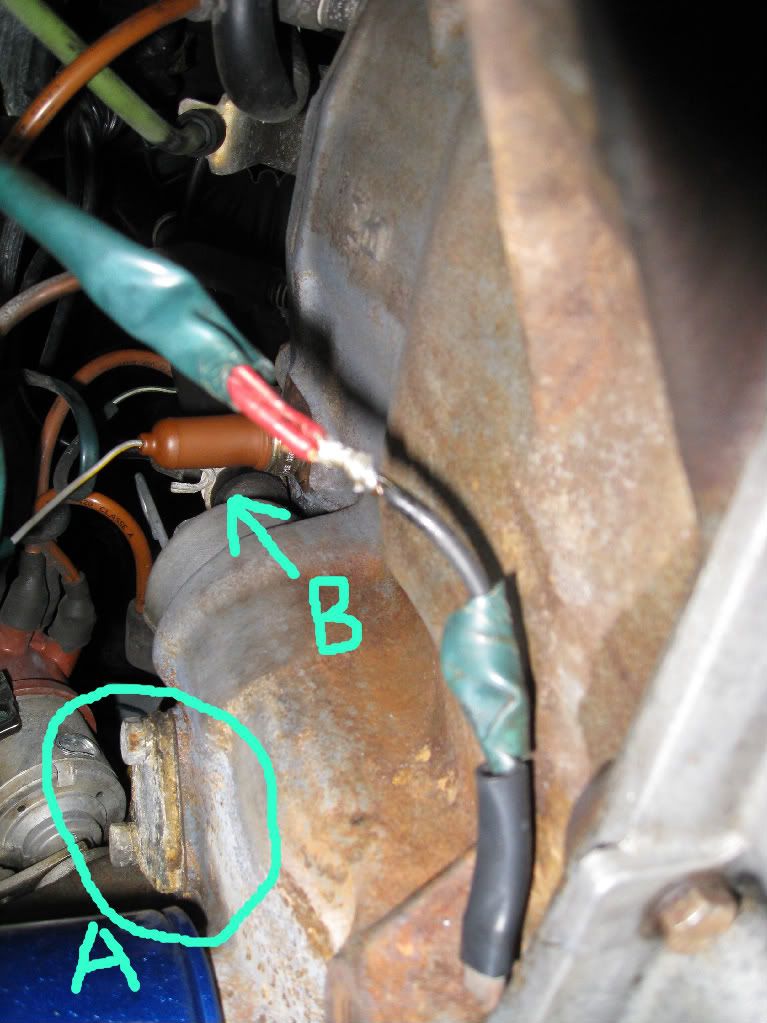Seagis
Wait . . . what ? ?
So I wanted to add more to this thread, but I couldn't add a bandwidth warning to it, so I figured I'd start a new thread and pick up where the old one left off.
I finally managed to get some pictures last night. While some of them show the orphaned hoses, some others are just extra pictures that show the rest of the engine area since maybe someone else may spot something remiss that I wouldn't have caught.

Now this diagram shows the hoses coming from the green nipples on the thermovalve being routed to two different locations (if I'm reading it correctly) but on the car they're both going into the side of the carb. Is this right?

This small hose coming from the coolant tank cap was just dangling straight down to the ground. Hmm . . .

The assembly on the right side of this picture mounts under the rear of the air cleaner. I rotated it 45 degrees to give you a better picture.

A shot from the right side of the bay, near the timing belt (obviously.) Nothing looks to be out of place here, at least not that I can tell.

I mistakenly thought that the small valve in the center of this picture was the EGR valve, so I removed it and flooded it with carb cleaner and some Seafoam, but it didn't appear to do anything. What exactly is this thing?

Here you see the gulp valve and the two hoses that caused me to start the original thread to begin with.

Up above the fuel filter, to about the 1:00 position, is another valve-type contraption that (I think) may be the EGR valve. Anyone want to confirm or deny this? Additionally, directly below that is what appears to me to be an unplugged port of some kind, although it may just be a recess where some bolt fits in to mount the head to the block.

A shot from inside the engine bay between the engine and the rear trunk area.

The whole engine bay. The blower in the upper left hand corner has been missing the hose that connects it to the air filter housing ever since I got it.

Under the carb at the manifold.

Another shot of what I think may be the EGR valve.

One final shot, above the block showing the area between the block and the firewall.
OK. Sorry for the huge post, but I guess too much information might have been better than not enough. My primary objective is to get those hoses put back the way they're supposed to go. I'm going to be ordering a replacement thermovalve from Matt in the next few days, and I have access to replacement hoses due to the fact that I work in the parts department of an automotive dealership, so this stuff is hanging on the spools on our back wall. :excited:
Thanks again, everyone!
Chris
I finally managed to get some pictures last night. While some of them show the orphaned hoses, some others are just extra pictures that show the rest of the engine area since maybe someone else may spot something remiss that I wouldn't have caught.

Now this diagram shows the hoses coming from the green nipples on the thermovalve being routed to two different locations (if I'm reading it correctly) but on the car they're both going into the side of the carb. Is this right?

This small hose coming from the coolant tank cap was just dangling straight down to the ground. Hmm . . .

The assembly on the right side of this picture mounts under the rear of the air cleaner. I rotated it 45 degrees to give you a better picture.

A shot from the right side of the bay, near the timing belt (obviously.) Nothing looks to be out of place here, at least not that I can tell.

I mistakenly thought that the small valve in the center of this picture was the EGR valve, so I removed it and flooded it with carb cleaner and some Seafoam, but it didn't appear to do anything. What exactly is this thing?

Here you see the gulp valve and the two hoses that caused me to start the original thread to begin with.

Up above the fuel filter, to about the 1:00 position, is another valve-type contraption that (I think) may be the EGR valve. Anyone want to confirm or deny this? Additionally, directly below that is what appears to me to be an unplugged port of some kind, although it may just be a recess where some bolt fits in to mount the head to the block.

A shot from inside the engine bay between the engine and the rear trunk area.

The whole engine bay. The blower in the upper left hand corner has been missing the hose that connects it to the air filter housing ever since I got it.

Under the carb at the manifold.

Another shot of what I think may be the EGR valve.

One final shot, above the block showing the area between the block and the firewall.
OK. Sorry for the huge post, but I guess too much information might have been better than not enough. My primary objective is to get those hoses put back the way they're supposed to go. I'm going to be ordering a replacement thermovalve from Matt in the next few days, and I have access to replacement hoses due to the fact that I work in the parts department of an automotive dealership, so this stuff is hanging on the spools on our back wall. :excited:
Thanks again, everyone!
Chris









